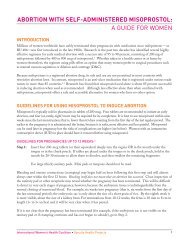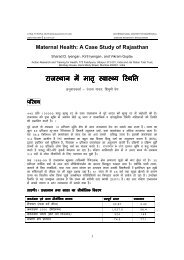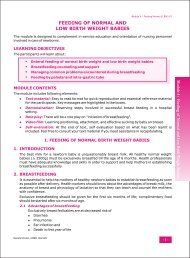Uterine evacuation with manual vacuum aspiration ... - CommonHealth
Uterine evacuation with manual vacuum aspiration ... - CommonHealth
Uterine evacuation with manual vacuum aspiration ... - CommonHealth
Create successful ePaper yourself
Turn your PDF publications into a flip-book with our unique Google optimized e-Paper software.
Manual Vacuum Aspiration (MVA)<br />
Each year, nearly 67,000 women die from unsafe abortion and about 5 million<br />
more are injured, often permanently (WHO 2007). Many of these women could<br />
be saved and their injuries prevented if clinicians in their communities were<br />
trained and equipped to use a simple, inexpensive medical device — the <strong>manual</strong><br />
<strong>vacuum</strong> <strong>aspiration</strong> (MVA) instrument.<br />
MVA involves the use of a plastic aspirator to evacuate the uterus for miscarriage<br />
management (incomplete, missed or inevitable abortion), first-trimester abortion<br />
(also called menstrual regulation), and endometrial biopsy. The <strong>manual</strong> <strong>vacuum</strong><br />
aspirator consists of a cylinder, plunger and valve. To evacuate the uterus, the<br />
aspirator is attached to a cannula which is inserted through the cervix to aspirate<br />
the contents of the uterus.<br />
The MVA device is handheld and portable. The procedure is quiet, fast and<br />
inexpensive (Dalton 2006) and can be performed in a wide variety of clinical<br />
settings because it does not rely on electricity. Unlike traditional dilatation and<br />
curettage <strong>with</strong> a sharp curette, an MVA procedure does not typically require<br />
general anesthesia. In a small percentage of cases (
















